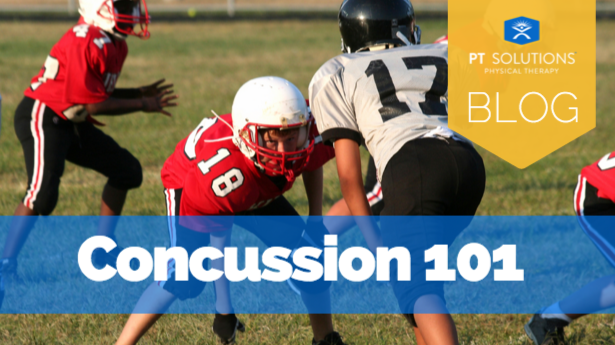Concussion 101: Understanding Signs and Prevention Methods

At PT Solutions, we see patients from all walks of life, from the high-level athlete to the casual athlete hobbyist. No matter where you fall along that spectrum, you may be at risk of concussion. This type of brain injury is especially prevalent among athletes, so being aware of the signs (and prevention methods) is important.
Concussion Symptoms
The signs of concussion can vary from one person to the next. Many people will experience only one of these symptoms while others may have most or all of them at one time. Symptoms include:
- Persistent headache
- Dizziness, either sporadic or consistent
- Nausea
- Vomiting
- Slow motor response
- Slow verbal response
- Disorientation or confusion
- Speech issues, usually in the form of slurred words
- Lack of coordination
- Memory loss
- Trouble concentrating (more than is usual)
- Sleeping more than normal
Preventing Concussions
The best way to prevent concussions depends upon the specific sport being played. For sports that require helmets, for example football, make sure that the helmet is worn 100 percent of the time while playing. Some players wear helmets that are not properly sized, and this can decrease the helmet’s effectiveness at preventing concussions. In fact, only around 15 to 20 percent of sports participants use helmets that fit properly. Helmets should be new or recently refurbished.
While playing, it is important that you do everything possible to avoid head contact with other players. Rules for fair play and safety should always be enforced and aggressive behavior should not be tolerated. Head-first contact is not only intensely painful, but it can also be a significant contributing factor in concussions. Wearing a mouth guard and strengthening neck and shoulder muscles may also help decrease chances of concussion. While the research is not conclusive at this time, it is certainly not harmful and could possibly be helpful.
Proper playing techniques are always important when it comes to any sport. If all the rules are followed and safety concerns are respected, the risk of concussion will naturally be significantly lower than it would otherwise be. If you suspect that an athlete may have a concussion, remove them from play and have them seen by the team’s athletic trainer or closest healthcare provider. Allowing a player back into the game before their injury is completely healed could have lifelong effects on the brain.
Visit our clinics in Kentucky or anywhere near you to learn more about concussion treatment options with PT Solutions or schedule your appointment here.